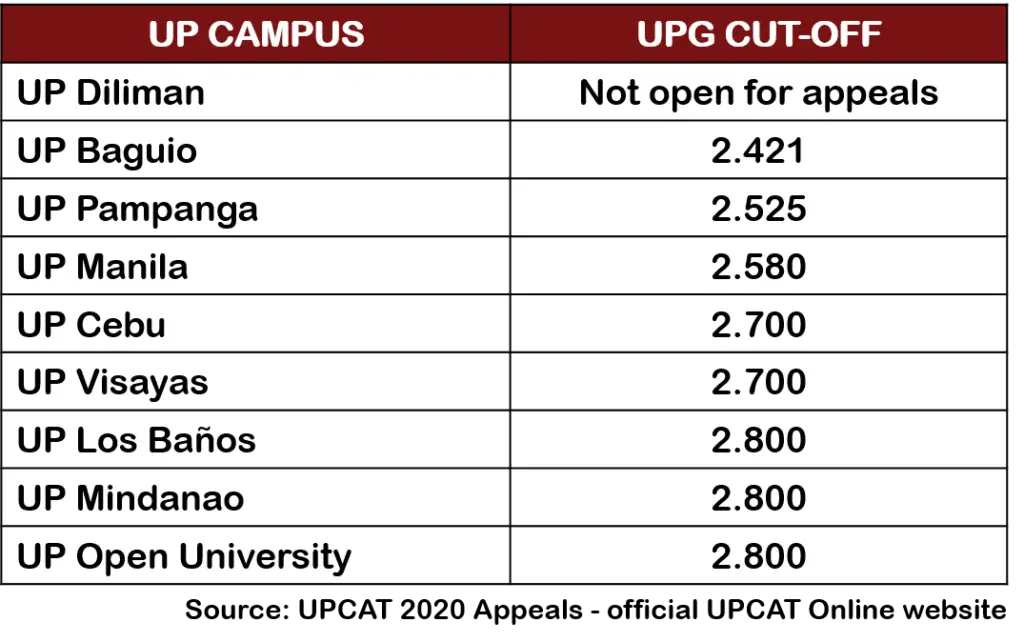Quota Courses in UP: A Guide to Choosing a Course

Every year, thousands of students take the entrance exam to get into the University of the Philippines (UP), one of the top universities in the Philippines.
Besides academic prestige, the university also offers the largest selection of undergraduate degree programs in the Philippines, spread across the eight UP constituent universities around the country.
If you’re reading this right now, you’re probably one of the many hopeful students fighting for the chance to study at UP. You may have heard or read somewhere that you must choose a non-quota course instead of a quota to increase your chances of getting into UP. However, some also say that this strategy is ineffective and will offer a different set of tips.
To set the record, we’ll discuss the truths and myths behind quota and non-quota courses at UP. If you’re still choosing which course to apply for, we’ll also discuss tips and strategies to pick the right course.
Reviewing for the UPCAT? Check out our Ultimate UPCAT Reviewer
Table of Contents
Quota vs. Non-Quota Course
Quota courses are usually popular course choices for students, making these courses harder to get into because of the limited slots and the resulting competition. On the other hand, non-quota courses refer to courses that can accommodate a considerable number of students. A common misconception for non-quota courses is that they are easier to apply for because a student is “guaranteed” a spot upon passing the college entrance exam.
Myths About Quota and Non-Quota Courses at UP
1. “Quota” courses and “double quota” courses
In truth, all courses in UP are quota courses. This is simply because there will always be a limited number of teaching professionals and facilities for each course. Although some courses can cater to a larger number of students, no course (even outside UP) can accommodate an unlimited number of students.
Quota courses are usually the popular courses students apply for or shift into. Since there are only a limited number of slots, applicants are usually ranked, and only those who make it through the cut-off are accepted.
“Double quota courses” is a non-technical term used to describe quota courses that are even harder to get into. In a later section, we’ll list down some of the most challenging courses to get into for each UP campus.
2. “Choosing a non-quota course will increase your chances of getting into UP”
When I was applying for UP, this was one of the many pieces of advice I received from many people. Because of this, I didn’t put the courses I wanted out of fear of not getting into UP if I did.
Your course choice won’t affect your chances of getting into UP. However, multiple factors do. Check out the next section to give you an idea of how these factors weigh in on your chances.
The UPCAT Screening Process
Every year, hundreds of thousands of applicants take the UP College Admission Test (UPCAT) to get a shot at studying at UP. However, only less than 15% of the takers are successful. The low acceptance rate is because UP can only provide for a much smaller student populace than the number of applicants.
Upon applying for the UPCAT, you will be asked to choose your first and second choices for UP campuses, followed by your top 4 course choices for each campus.
Once you’ve finished the UPCAT, you will receive your University Predicted Grade (UPG), a combination of your UPCAT score and the average of your high school grades. Your UPG is the main qualifying factor for studying at UP.
The UP System will first rank the applicants’ UPGs against each other. After ranking the applicants, the system will look at each applicant’s (starting from the top of the rank) UP campus choices and check whether their UPG falls within the campus’s cut-off grade.
If their UPG falls within the cut-off of their first choice of campus, they will be granted a slot on that campus. Once they’ve been assigned a campus, the system will now look at their course choices and check the availability of slots for each one.
Note: The system will consider the top 1-course choice before moving on to the next choices. The system will no longer check the other choices if a slot is available for the top 1-course choice.
Different UP campuses have different cut-off grades. The cut-off grades are primarily based on the number of applicants for that campus. Simply put, if a UP campus has a considerably higher number of applicants than other campuses, they will have a higher cut-off grade.
The cut-off grades can change yearly depending on different factors in the UPCAT application process. To give you an idea, here are the cut-off grades for the 2020 UPCAT:

Degree Program With Available Slot (DPWAS)
Sometimes, applicants pass for their UP campus but not their chosen courses. A student is tagged with the Degree Program with Available Slot (DPWAS) status when this happens.
Students who are DPWAS are still allowed to enroll in the campus assigned to them. However, they must first look for a course with available slots that they can enroll in. The list of courses with available slots is usually released a few days after successful UPCAT takers have confirmed their slots.
The DPWAS students can then apply for the courses on the list in hopes of being accepted. However, it’s essential to know that you aren’t guaranteed a slot in the course you applied for. You will also compete with fellow DPWAS students for the slots.
As a DPWAS applicant, let me share my personal experience: Upon hearing that I passed the UPCAT, I was pleased. However, I was also anxious because I didn’t even have a course. Once the course list came out, I chose a course that I thought I would be interested in. After a year in the course and lots of thinking, I decided it wasn’t the course for me and shifted to another course. However, I know a lot of fellow DPWAS students who learned to love their courses and stay in them.
List of In-Demand Courses at UP
Here is a list of the most in-demand courses for some UP campuses based on student feedback and demand for these courses throughout the years. Take note that the demand for these courses may shift depending on the job market and the status of different industries.
UP Diliman
- BS Business Administration and Accountancy
- BS Business Administration
- BS Civil Engineering
- BS Biology
- BS Molecular Biology and Biotechnology
UP Manila
- BS Biology
- BS Biochemistry
- BS Nursing
- BS Dental Medicine
- BS Computer Science
UP Los Baños
- BS Civil Engineering
- BS Chemical Engineering
- BS Computer Science
- BS Electrical Engineering
- BS Nutrition
UP Visayas
- BS Accountancy
- BS Chemical Engineering
- BS Business Administration
- BS Computer Science
- BS Statistics
Important reminder: Even if the course/s you want to pursue is/are on the list, don’t be disheartened. Always include the course/s you want in your course choices. There will always be a chance for you.
How To Choose a Course in UP: 4 Tips
Now that we’ve distinguished fact from fiction when it comes to choosing your courses in UP, here are some tips that may help you make a decision:
1. Follow your passion
This is the most cliche advice you will hear, but it’s also the truest. Choose a course that you have a genuine interest in. By doing so, studying for your course will seem less like a chore and more like enriching your hobby.
2. Don’t count your eggs before they hatch
That is, don’t choose courses based on the salaries of their job prospects. This is a common mistake that a lot of students make. Often, students realize they are unhappy with their current course because there’s no genuine interest and consider shifting.
Every course has the potential to land you a great job. However, your course will not determine your success in the future– your skills and hard work will.
3. Find out if you can handle the nature of the coursework
Different courses offer different experiences. Before applying for a course, ensure you’re compatible with the nature of the coursework. Some courses may require you to be physically fit to go on the field, while some will have you staring at the computer screen most of the time.
4. Look at what’s in demand
Take some time and research which fields are booming and which are declining. You could also look out for career paths that are considered niche and those that are oversaturated.
Whatever you choose, always remember that success is achievable in any field, depending on the person.
What Do I Do if I Don’t Get My Chosen Course?
So what if you didn’t get your dream course and still want to pursue it? Don’t fret. Even though it may take a bit longer, you can achieve your goals differently.
1. For DPWAS students
As mentioned earlier, DPWAS students must wait for the list of courses with available degree programs before enrolling. Depending on the course you want, there’s a chance that the course will be on the list. Every year, many students don’t follow through with their UP application. Because of this, the vacant slots will be up for grabs.
However, if your dream course isn’t on the list, you can consider the succeeding options below.
2. Shifting
Shifting means that you are transferring from your current course to another course. This means that you also shift to a different UP campus that has your desired course.
Take note that you can only shift out after completing one academic year in your current course. Check out this article to learn more about the different types of shifters and the shifting process in UP.
3. Transferring
Transferring is recommended for those who didn’t pass the UPCAT but still want to pursue their college education at UP. Similar to shifting, you can only apply for transfer after one academic year.
Related: The Ultimate UPCAT Reviewer (with Free Practice Tests and Answer Keys)
Written by Ruth Raganit
Ruth Raganit
Ruth Raganit obtained her Bachelor of Science degree in Geology from the University of the Philippines – Diliman. Her love affair with Earth sciences began when she saw a pretty rock and wondered how it came to be. She also likes playing video games, doing digital art, and reading manga.
Copyright Notice
All materials contained on this site are protected by the Republic of the Philippines copyright law and may not be reproduced, distributed, transmitted, displayed, published, or broadcast without the prior written permission of filipiknow.net or in the case of third party materials, the owner of that content. You may not alter or remove any trademark, copyright, or other notice from copies of the content. Be warned that we have already reported and helped terminate several websites and YouTube channels for blatantly stealing our content. If you wish to use filipiknow.net content for commercial purposes, such as for content syndication, etc., please contact us at legal(at)filipiknow(dot)net